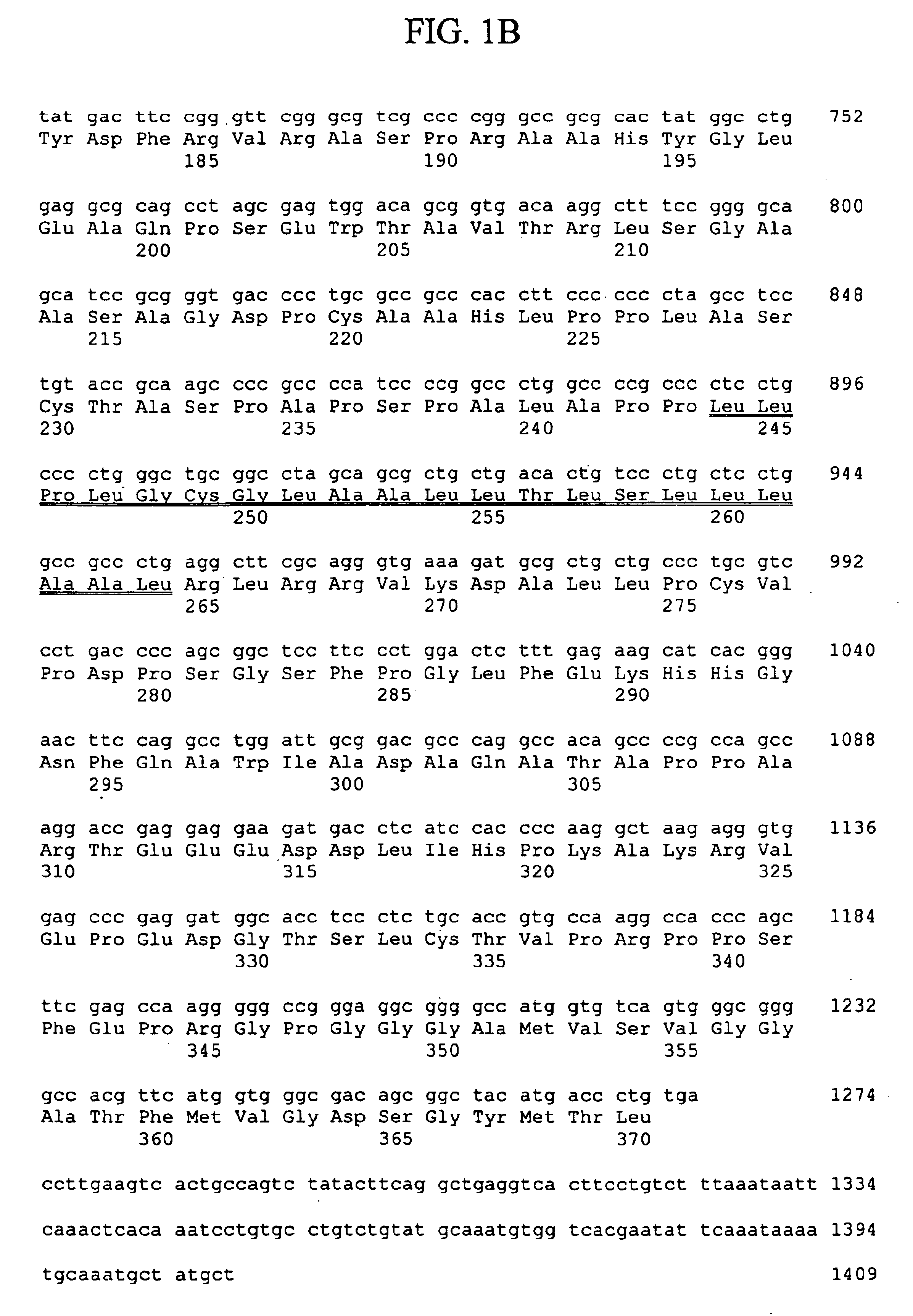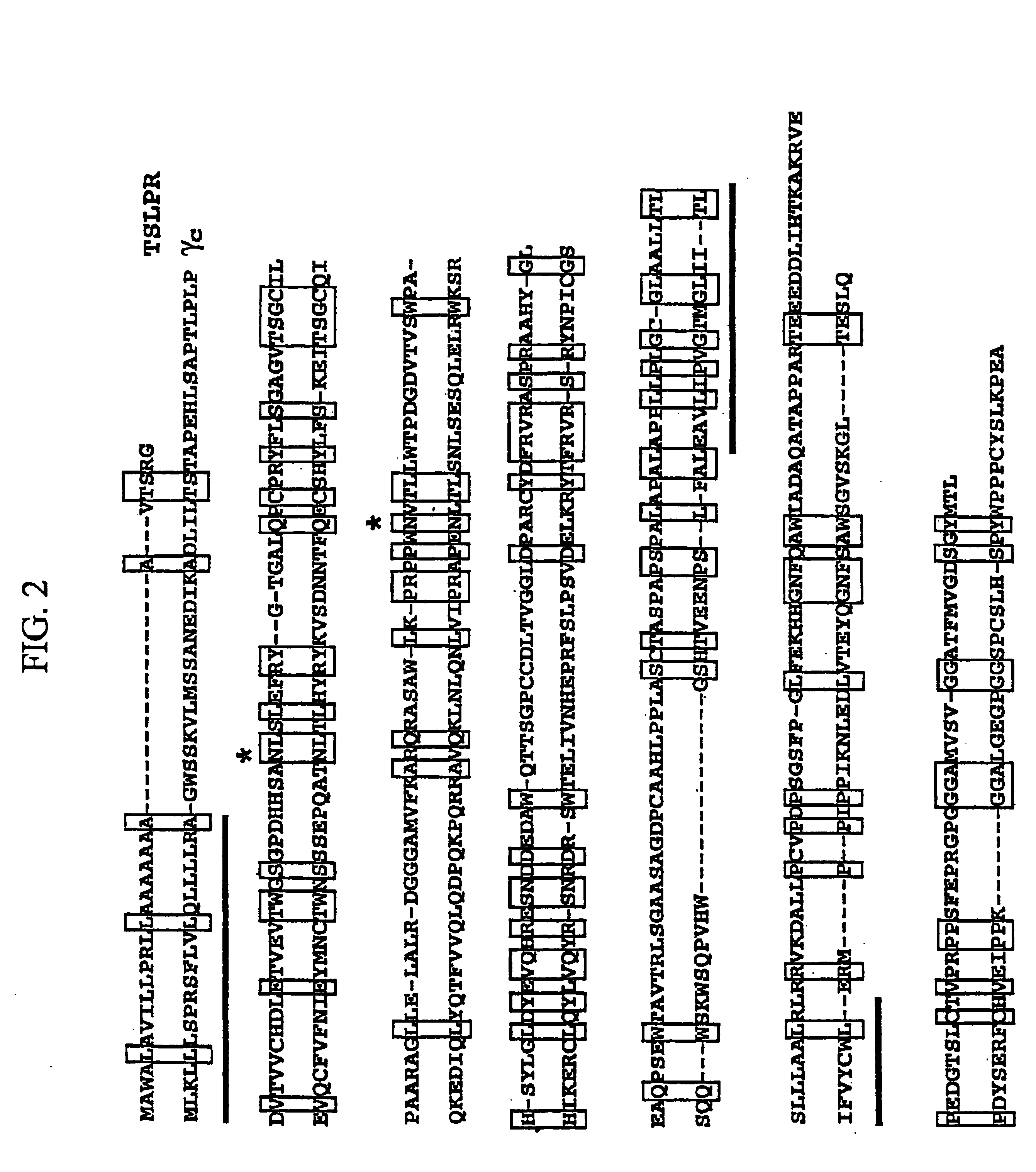Thymic stromal lymphopoietin receptor molecules and uses thereof
a technology receptor, which is applied in the field of thymic stromal lymphopoietin receptor (tslpr) polypeptides and nucleic acid molecules, can solve the problem that the potential for the development of novel therapeutics based on the human genome is still largely unrealized
- Summary
- Abstract
- Description
- Claims
- Application Information
AI Technical Summary
Benefits of technology
Problems solved by technology
Method used
Image
Examples
example 1
Cloning of the Murine and Human TSLPR Polypeptide Genes
[0315]Generally, materials and methods as described in Sambrook et al., supra were used to clone and analyze the genes encoding murine and human TSLPR polypeptides.
[0316]Sequences encoding the murine TSLPR polypeptide were identified in a BLAST search of an EST database using sequences corresponding to the cytoplasmic domain of the erythropoietin receptor. Several overlapping murine ESTs, which encode a novel type I cytokine receptor molecule, were obtained in the BLAST search. The cytoplasmic domain of the cytokine receptor encoded by these sequences was found to share significant similarity to that of the common cytokine receptor γ chain (γc), the erythropoietin receptor, and the IL-9 receptor α chain.
[0317]The common cytokine receptor γ chain is an essential subunit of the receptors for IL-2, IL-4, IL-7, IL-9, and IL-15 (Noguchi et al., 1993, Science 262:1877-80; Kondo et al., 1994, Science 263:1453-54; Kondo et al., 1993, Sc...
example 2
TSLPR Polypeptide Expression
[0323]A cDNA construct encoding the entire open reading frame for murine TSLPR was transcribed and translated in vitro in the presence of 35S-methionine and the product resolved by SDS-PAGE. FIG. 6A illustrates an autoradiogram of the gel in which a single species of approximately 40 kD was obtained.
[0324]FIG. 6B illustrates the immunoprecipitation of murine TSLPR polypeptide in the growth factor-dependent pre-B-cell line NAG8 / 7 using a rabbit polyclonal antiserum raised against the extracellular domain of murine TSLPR polypeptide. The rabbit polyclonal antiserum was generated against murine TSLPR polypeptide-glutathione S-transferase fusion protein which was cloned into the pGEX4T2 expression vector (Pharmacia) and expressed in bacteria. Prior to metabolic labeling, NAG8 / 7 cells were grown in RPMI supplemented with 10% fetal bovine serum, antibiotics, and TSLP.
[0325]NAG8 / 7 cells were metabolically labeled with 35S-methionine and cysteine, lysed in 50 mM ...
example 3
TSLPR mRNA Expression
[0326]The tissue distribution of murine TSLPR was examined by northern blot analysis. A mouse multiple tissue northern blot (Clontech, Palo Alto, Calif.) was screened with a 32P-labeled TSLPR cDNA probe using standard techniques. Murine TSLPR mRNA transcripts were detected in nearly all of the tissues examined, with highest levels of expression being detected in the lung, liver, and testis (FIG. 6C). Lower levels of expression were detected in the heart, brain, spleen, and skeletal muscle. Two transcripts of approximately 2 kb and 2.2 kb were detected in some tissues, whereas only a single transcript of approximately 2 kb was detected in other tissues. The broad tissue distribution of murine TSLPR mRNA differs from the relatively restricted lympho-hematopoietic pattern of expression observed for γc.
[0327]The expression of TSLPR mRNA can be localized by in situ hybridization as follows. A panel of normal embryonic and adult mouse tissues is fixed in 4% paraformal...
PUM
| Property | Measurement | Unit |
|---|---|---|
| melting temperature | aaaaa | aaaaa |
| melting temperature | aaaaa | aaaaa |
| melting temperature | aaaaa | aaaaa |
Abstract
Description
Claims
Application Information
 Login to View More
Login to View More - R&D
- Intellectual Property
- Life Sciences
- Materials
- Tech Scout
- Unparalleled Data Quality
- Higher Quality Content
- 60% Fewer Hallucinations
Browse by: Latest US Patents, China's latest patents, Technical Efficacy Thesaurus, Application Domain, Technology Topic, Popular Technical Reports.
© 2025 PatSnap. All rights reserved.Legal|Privacy policy|Modern Slavery Act Transparency Statement|Sitemap|About US| Contact US: help@patsnap.com



